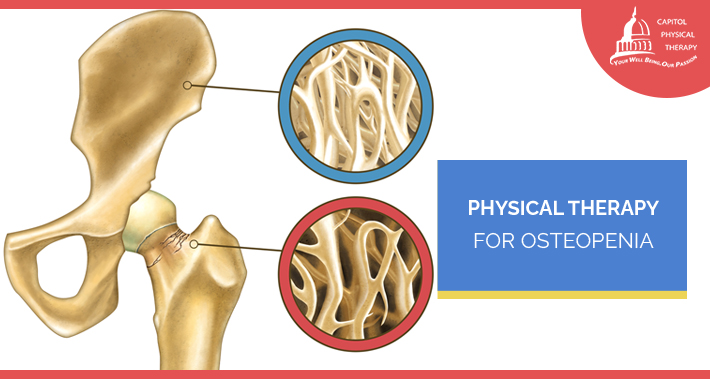
As you age, breaking bones can become a larger cause for concern.
You’ve probably heard about osteoporosis before, and about how physical therapy for osteoporosis can help.
However, you may not know that you can begin physical therapy before you develop osteoporosis to prevent yourself from ever developing it.
This is especially true if you have, or are at risk for, osteopenia.
Orthopedic health physical therapy can help with osteoporosis, as well as osteopenia.
We’re Capitol Physical Therapy in Washington DC, and we can help.
But for now, let’s take a closer look at osteopenia.
What Does Having Osteopenia Mean?
If you have osteopenia, it means you have lower bone density than you normally should.
You may think of your bones as being solid objects, but they’re actually porous.
That’s true for everybody, and it’s not cause for concern.
But the density is.
As you age, your bones may become less dense and more porous – we can measure this with a DEXA bone scan.
This can increase your risk of fractures from everyday activities, or from regular slip and fall accidents
RELATED: Fall Prevention Physical Therapy Clinic Near Me
If you have osteopenia, you have lower bone mineral density than normal.
If you have osteopenia, you’re more likely to develop osteoporosis as a result.
It’s similar to how if you have insulin resistance, you’re more likely to develop diabetes.
RELATED: Physical Therapy Treatments For Diabetes.
What Are The Symptoms Of Osteopenia?
There are no known symptoms of osteopenia, so it’s often screened for at your annual medical checkup.
Losing bone density doesn’t cause any pain or anything else that is easily identifiable as a symptom.
To know if you have osteopenia, you would have to have your bone density tested to see if it is below what is normally expected.
Typically, bone density testing is recommended for women who are 65 or older.
RELATED: Healthy Seniors Physical Therapy Near Me
If you’re a woman who’s 65 or younger you may also be at greater risk if you:
- Are postmenopausal
- Have broken a bone in the past
- Have a history of chronic alcohol or tobacco use
- Have a history of eating disorders
RELATED: Women’s Health Physical Therapy Clinic
Men can have osteopenia as well, but it’s far more common in women.
Despite the lack of symptoms, there are some subtle signs you can look out for as you age.
If you lose more than one and a half inches of height as you age, it may indicate that your spine is shrinking.
If your upper back begins rounding and pushing your head forward, also known as kyphosis, it can indicate your spinal bones are changing shape due to bone density loss.
If you’ve broken a bone from normal activity, like vacuuming, or from something with very little impact, like falling from standing height, you might have bone density loss.
What Causes Osteopenia?
There are a few risk factors that can contribute to the development of osteopenia.
The most common risk factor is aging.
Your bone mass peaks at age 35 before your body begins breaking down old bone faster than it builds new bone.
This process means you may lose some bone density.
Women also lose bone density as they age faster than men do due to low estrogen levels after menopause.
Other risk factors include:
- Being older than 50
- Family history of low bone mineral density
- Removal of ovaries before menopause
- A diet low in calcium and vitamin D
- Menopause before the age of 45
- Smoking or using other types of tobacco
- Not getting enough exercise
- Drinking too much caffeine or alcohol
There are also some conditions that can increase your risk of osteopenia, such as:
- Bulimia
- Anorexia
- Hyperthyroidism
- Cushing’s syndrome
- Hyperparathyroidism
- Inflammatory diseases like lupus, Crohn’s disease, or rheumatoid arthritis
Does Osteopenia Always Turn Into Osteoporosis?
It’s important to know that a diagnosis of osteopenia doesn’t always progress to osteoporosis.
Getting diagnosed with osteopenia can actually give you a good opportunity to take better care of your bone health and prevent developing osteoporosis.
This is something a physical therapist can help with by guiding you in exercises and lifestyle changes that can decrease your risk.
You may also want to consult with a licensed dietician to see if changes in your diet can improve mineral absorption needed to keep bones strong.
If you don’t take care of your bone health after you are diagnosed with osteopenia, it can turn into osteoporosis.

How Can Physical Therapy Help With Osteopenia?
Luckily, there are many ways physical therapy can help with your osteopenia to keep it from becoming worse.
Your physical therapist will be able to create a personalized treatment plan for you that takes into account your lifestyle, needs, and goals.
They’ll take any other physical issues or conditions you may have as well.
As you progress through physical therapy, your physical therapist can tailor your program by adding exercises to help your bones grow stronger.
Typically, exercise will focus on posture guidance and gait training, vestibular therapy to address poor balance issues, stretches, and strengthening exercises.
This is usually a combination of weight bearing exercises and resistance exercises
Weight bearing exercises use your body as natural weight to help you build strength and train your muscles and bones to bear weight in your day to day activities.
Weight bearing exercises may include:
- Tai chi
- Mat or Reformer Pilates
- Running or walking at a quick pace
- Racket sports, like tennis, badminton, squash, or pickleball
- Dancing
Resistance exercise use a form of resistance to help build strength.
For example, you might use weights or resistance bands in exercises.
Resistance exercises also use gravity as a natural form of resistance (like climbing stairs, doing push ups or squats, or other body weight exercises).
However, exercise isn’t the only component of a good physical therapy program for osteopenia.
A dietitian can also help you develop a healthy and varied diet that targets your bone strength and density.
Book Your Appointment With Capitol Physical Therapy Today
Whether your primary health concern is osteopenia or something else, we can help.
Here at Capitol Physical Therapy, we can design a treatment plan that meets your needs so you can worry less about your health as you age.
Book your appointment with Capitol Physical Therapy today.
1331 H St NW #200,
Washington, DC 20005
- https://g.page/capitolptdc
9560 Pennsylvania Ave. # 202,
Upper Marlboro, MD 20772
- https://goo.gl/maps/zjL4NnnuThRhrcS86
Capitol Physical Therapy offers orthopedic and other pain related solutions, with our versitile team of physical therapists in Washington, DC